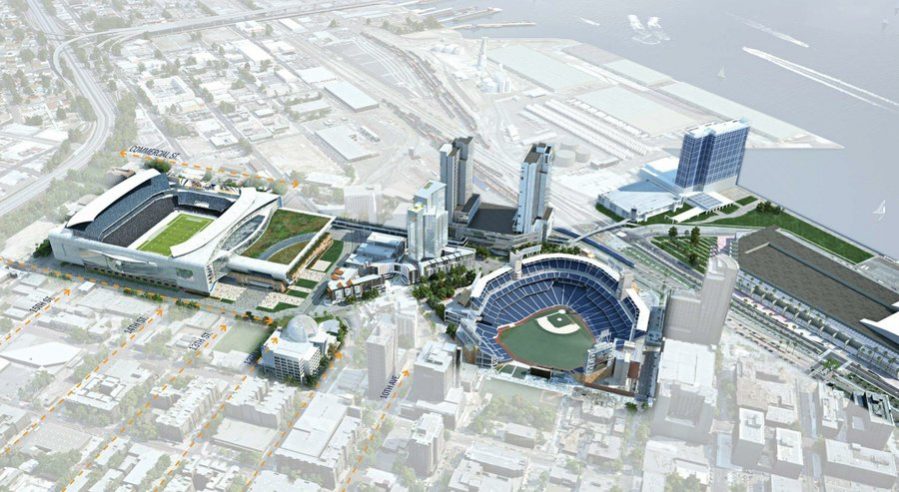The effect of sports venues on surrounding real estate is often understated and overlooked.
When the new Chargers Stadium is approved by voters in November, it will become the most expensive development project in downtown San Diego history.
At $1.8 billion, the stadium and adjoining convention center — called the “convadium” in local parlance — will eclipse the Manchester Pacific Gateway by more than $500 million.
The convadium will be located on the east side of Petco Park, bounded by 12th and Imperial and K and 16th, on the current locations of Tailgate Park and the MTS bus yard. The project will be funded by a municipal bond repaid through a 4% increase in the hotel tax from 12.5% to 16.5%. An additional $650 million will come from the San Diego Chargers and the National Football League (NFL). The complex will be publicly owned. Further, the Chargers will pay $15 million a year to the city in the form of rental payments.
While the stadium is receiving the brunt of public attention, the convention center is the most valuable player in San Diego’s downtown revitalization efforts. San Diego relies on convention-heavy tourism ranging from Comic-Con to conferences by the Society for Neuroscience. A new, 385,000 square foot convention hall is planned, making the solidly eighth-largest U.S. city all the more alluring.
For all the focus paid to billion dollar projects in San Diego, the proposed complex is seen more as a flashy sports venue than the city-shaping real estate project it is. If anything, the convadium is a harbinger of greater urbanization — a boon for San Diego’s current and future residents, and of course property transactions.
Chargers Stadium and housing indicators
Studies have shown residential property to increase in value when within 2.5 miles of a sports stadium by improving the quality of life in the community. With quality of life improvements and attractive hedonistic amenities, demand follows — prompting more visitors to relocate and stay.
San Diego is below California’s median age and above it for median income. Thus, it is in a unique position to meet demand in spite of rising affordability. The county’s jobs recovery is outpacing the rest of the state, meaning more homebuyers are better equipped to save up for a down payment.
At least in theory.
Related article:
The problem? Demand for housing is increasing faster than new units are being made available.
Claustrophobic zoning ordinances are limiting housing density, exacerbating the on-going lack of housing.
Generation Y (Gen Y) values urban living due to the proximity of work and entertainment (such as multi-million dollar sports stadiums). New sports venues will only further entice this new demographic of homebuyers and drawn them into the urban core of the city.
Without sufficient rezoning, the San Diego City Council deliberately allows prices to rise by not allowing for an increase in housing starts. As a consequence, the city at some point will stagnate and gentrification of existing low-density housing will increase.
Related article:
Given the sluggish actions by local government to address the crisis caused by high prices and low housing permits, the convadium development will only aggravate the housing (and parking) imbalance.
Low-tier housing prices skyrocketed in the latter half of 2012 and have continued to rise ever since. This is due in part to speculators investing in San Diego’s attractive market and exacerbated by low mortgage rates which increase buyer purchasing power. Prices are expected to descend starting in mid-2017 after home sales volume falls off with rising rates.
San Diegans interested in preserving their thriving and diverse population need to demand action be taken to provide more housing — particularly of the mid- to low-tier variety — in the area surrounding the stadium and convention center.
Ultimately, the construction of the convadium will encourage tangential commercial development in the downtown district. However, this type of construction will not solve — but merely add to — the problems of housing availability and affordability in downtown San Diego. Politically active residents (and agents) advocating for higher density housing based on permissive residential zoning have an opportunity to balance needs. If successful, the convadium will be a short-term pain leading to a long-term gain.
Look for future updates on the convadium influence on housing as the election nears and construction begins.




















thanks..good points of interest.